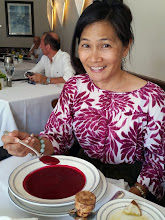 |
| The Peace Rose |
Meilland launched what was left of his new rose in France, and named it, "Madame Antoine Meilland," after his mother. Over time, he learned that the rose was being cultivated in Italy, where it was named, "Gioia" (Joy), and Germany, where it was known as "Gloria Dei" (Glory of God). It was only after the liberation of France in 1944 that Meilland heard from Robert Pyle, an American rose breeder in Pennsylvania who ended up with one of the parcels of budwood, who notified him that the rose had survived the war and was being grown successfully.
 |
| A rose by any other name... ought to be made of strawberry and banana ice! A vendor prepares baba-hera in the shape of a rose at Mitsuwa Marketplace. |
Given the Peace Rose's history, I was profoundly moved when I noticed a bright pink and yellow rose made of sorbet, blossoming under the hands of a skilled vendor at a stall in Mitsuwa Marketplace last Sunday afternoon. His stall, which sold the "baba-hera ice," was part of a "Rising Tohoku Food Fair," which showcased the culinary specialties of the region of Japan that was ravaged by a catastrophic earthquake and tsunami in March of 2011.
The words, "baba" - which means "old woman," and "hera," which means "spatula," belie the ethereal beauty of this unique treat. I almost missed baba-hera stall, walking past displays of richly marbled Wagyu beef, intriguing kiritanpo rice sticks, and colorful Japanese sodas.
 |
| Unusual tanabata decoration - kind of like a sumo wrestler pinata. |
In July of 2011, three months after the earthquake and tsunami, the organizers of six traditional festivals in the
six prefectures of Tohoku, collaborated to present
for the first time ever, a combination of all of their festivals in the city of Sendai, in order to celebrate this northeastern region of Japan, and to encourage hope among the people.
At Mitsuwa that day, there were performances by dancers and drummers from Morioka, and Nobuta dancers from Aomori. A large empty space that for years used to contain a stationery store, a bookstore, and a couple of other retailers, had been cleared to create a common area, with tables and chairs for activities such as this. That day, it was festooned with elaborate tanabata decorations typical of Sendai, and paper lanterns of the type used in the Akita Kanto Festival.
 |
| Dancers and drummers from Morioka, Iwate Prefecture. The colorful streamers on the back of the drummers' outfits are meant to ward off evil. |
Although I hate waiting in line for anything, queuing up for my own baba-hera was an experience. There was something calming and magical about watching this iced confection being created in front of our eyes. A little girl asked for hers to be made of all pink strawberry sorbet. I couldn't hear what others in line before me asked for, but I saw more pink in some, more yellow in others.
The baba-hera ice was refreshing and pretty. Moreover, seeing someone making it by hand made me stop and if not smell the roses, enjoy the expertise that created them out of sorbet. And it made me think about the all-too-human need to reclaim a positive outlook after disaster and tragedy.
Three years later, recovery from the earthquake and tsunami in Tohoku is far from complete. One can assess how far things need to progress, depending on whether one chooses to accept positive or negative updates. But one thing is for certain: giving up is not an option. If it was, no one would continue to find joy in festivals, foods that bring up feelings of nostalgia, or roses made out of sorbet.






No comments:
Post a Comment